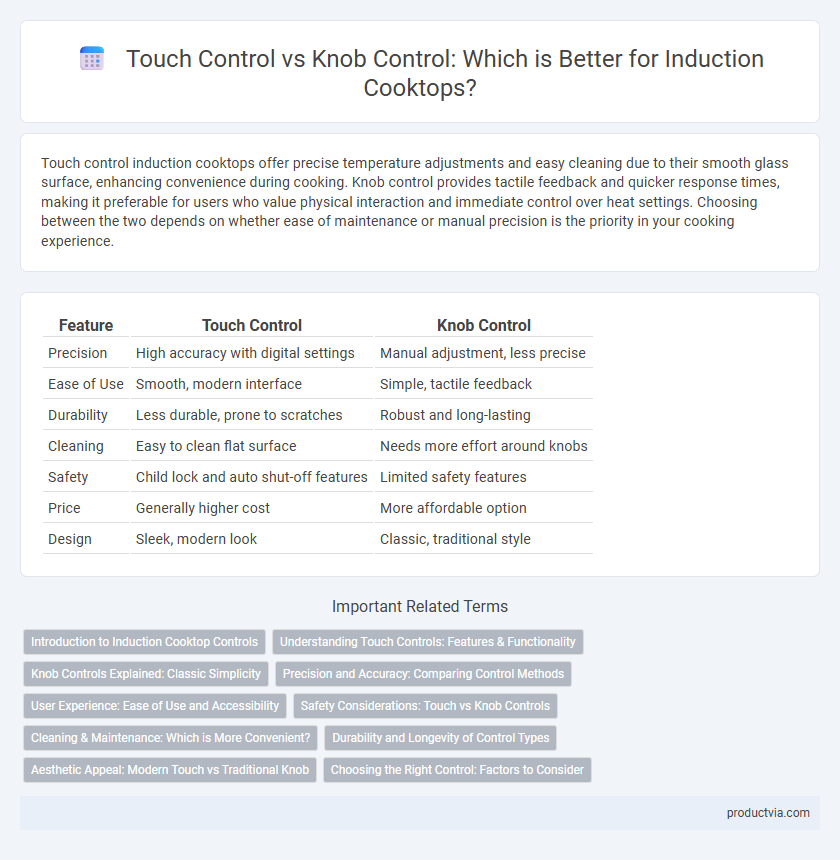Touch control induction cooktops offer precise temperature adjustments and easy cleaning due to their smooth glass surface, enhancing convenience during cooking. Knob control provides tactile feedback and quicker response times, making it preferable for users who value physical interaction and immediate control over heat settings. Choosing between the two depends on whether ease of maintenance or manual precision is the priority in your cooking experience.
Table of Comparison
| Feature | Touch Control | Knob Control |
|---|---|---|
| Precision | High accuracy with digital settings | Manual adjustment, less precise |
| Ease of Use | Smooth, modern interface | Simple, tactile feedback |
| Durability | Less durable, prone to scratches | Robust and long-lasting |
| Cleaning | Easy to clean flat surface | Needs more effort around knobs |
| Safety | Child lock and auto shut-off features | Limited safety features |
| Price | Generally higher cost | More affordable option |
| Design | Sleek, modern look | Classic, traditional style |
Introduction to Induction Cooktop Controls
Induction cooktops offer two primary control methods: touch control and knob control, each providing distinct user experiences. Touch controls allow for precise temperature adjustments and sleek, easy-to-clean surfaces with digital interface feedback. Knob controls deliver tactile feedback and intuitive operation, appealing to users preferring mechanical dials for quick, direct heat regulation on induction stoves.
Understanding Touch Controls: Features & Functionality
Touch control for induction cooktops offers precise temperature adjustments and intuitive operation through a sleek, flat interface, enhancing ease of cleaning and modern kitchen aesthetics. Features often include digital displays, timer settings, and child safety locks for improved functionality and safety. This technology allows for seamless control with minimal effort, reducing physical wear compared to traditional knob controls.
Knob Controls Explained: Classic Simplicity
Knob controls on induction cooktops offer classic simplicity with tactile feedback, allowing precise heat adjustments through physical rotation. Their intuitive design enhances user experience by enabling quick, direct control without the need for navigating touch-sensitive panels. This straightforward interface is preferred in environments where durability and ease of use are prioritized.
Precision and Accuracy: Comparing Control Methods
Touch control systems on induction cooktops offer greater precision and accuracy by enabling fine adjustments in temperature settings with minimal delay, ensuring consistent heat levels. Knob control allows for rapid and intuitive changes but may lack the exact incremental adjustments that touch sensors provide. Advanced touch controls often integrate digital displays that enhance precise cooking compared to the analog nature of knobs.
User Experience: Ease of Use and Accessibility
Touch control induction cooktops offer a sleek, modern interface that allows precise temperature adjustments with simple taps or slides, enhancing ease of use for tech-savvy users. Knob control models provide tactile feedback and intuitive operation, making them accessible for visually impaired users and those preferring physical controls. Both control types cater to different user preferences, but touch controls typically allow for more customizable settings and easier cleaning.
Safety Considerations: Touch vs Knob Controls
Touch control panels on induction stoves enhance safety by reducing the risk of accidental changes in heat settings since they require deliberate gestures, unlike knob controls which can be easily bumped or turned unintentionally. Touch controls often feature child lock functions to prevent unintended activation, offering an extra layer of protection not typically available on knob-operated cooktops. Knob controls provide tactile feedback and can be easier to operate when hands are wet or greasy, but they lack the advanced safety features and streamlined surface that minimize dirt buildup and potential fire hazards in touch control designs.
Cleaning & Maintenance: Which is More Convenient?
Touch control induction cooktops offer a smooth, flat surface that is easier to clean as spills do not get trapped around knobs, reducing grime buildup. Knob control models have crevices where food particles and grease can accumulate, requiring more effort and time for thorough cleaning. The seamless design of touch controls allows quicker maintenance, making them more convenient for users prioritizing cleanliness.
Durability and Longevity of Control Types
Touch control panels on induction stoves offer enhanced durability due to their sealed, flat surfaces that resist spills and wear, reducing the risk of malfunction over time. Knob controls, while often favored for tactile feedback, are more susceptible to mechanical wear and may require replacement or repair with prolonged use. Choosing touch control systems can therefore extend the lifespan of the cooktop's interface, contributing to overall appliance longevity.
Aesthetic Appeal: Modern Touch vs Traditional Knob
Touch controls on induction cooktops offer a sleek, minimalist aesthetic that seamlessly integrates with contemporary kitchen designs, enhancing visual appeal through smooth, flat surfaces and glowing LED indicators. Knob controls provide a classic, tactile experience with a more traditional look, featuring physical dials that can complement rustic or vintage kitchen styles. The choice between touch and knob controls significantly impacts the overall kitchen ambiance, balancing modern sophistication against timeless familiarity.
Choosing the Right Control: Factors to Consider
Touch control panels offer precise temperature adjustments, easy cleaning, and a sleek design ideal for modern kitchens, while knob controls provide tactile feedback and quicker manual operation favored by users who prefer traditional handling. Consider factors such as user preference for ease of use, safety features like child locks available on touch controls, responsiveness, and maintenance requirements when choosing between touch and knob controls for an induction stovetop. Energy efficiency and compatibility with cookware remain consistent across both control types, making user experience and convenience the primary deciding factors.
Touch control vs Knob control for induction cooktops Infographic

 productvia.com
productvia.com